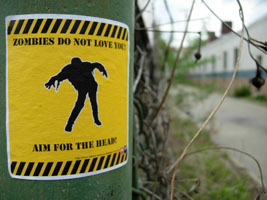The residents of Lake Worth, Florida were wakened at 1:45 am to an “outbreak of zombies” push notification during a power outage on May 22. What the…? I would think that if this were to happen on a regular day in the daytime that you would be likely to laugh it off but when it happens in the middle of the night during a power outage, it might be a little concerning. Just a little, anyways. The full notification said the following: “There are now far less than seven-thousand-three-hundred-eighty customers involved due to extreme zombie activity.” It stated that this was a zombie alert for those in Lake Worth and Terminus; Terminus being a fictional town in the AMC TV series The Walking Dead.
City officials were quic k to set the story straight but Ben Kerr, the city’s information officer maybe should have used different wording to his statement. “I want to reiterate that Lake Worth does not have any zombie activity currently and apologize for the system message.” This kind of implies that things are good now folks, but be ever vigilant because you never know how things may change. So don’t break out your barbed wire covered baseball bats, there is no imminent zombie apocalypse, as of yet.
k to set the story straight but Ben Kerr, the city’s information officer maybe should have used different wording to his statement. “I want to reiterate that Lake Worth does not have any zombie activity currently and apologize for the system message.” This kind of implies that things are good now folks, but be ever vigilant because you never know how things may change. So don’t break out your barbed wire covered baseball bats, there is no imminent zombie apocalypse, as of yet.
Now, when I started to write this blog, I thought that it could go a couple of different ways and if you read me regularly, you will know of my ability to digress from the original topic. I often take a circuitous route to an end. I could focus on the scientific probability of zombies like those in popular culture, or the cases of zombie-like activity in the animal world, (both of these I may revisit at a future date) but what I am choosing to concentrate on today are emergency messaging systems.
This zombie messaging is not the first time that these emergency systems have sent out false alerts. (It isn’t even the first time an American community has been warned of these shuffling, slobbering threats to healthy brains everywhere. 2013 was an especially good year for them.) In February of this year, the US National Weather Service sent out a tsunami warning to the East Coast of the US. It was a test to their alerts on cell phones. They maintained that it was just a test but nowhere on the alert was the word “test”. This was less than a month after the imminent missile attack from North Korea message that was released in Hawaii, panicking residents for almost 40 minutes. This message even stated, this is not a test. Yeah, I think I would feel a little nervous about this too and may be reaching for my blankie.
The world is rapidly changing and the way information is shared and reshared is immediate and these events of false reports will probably continue to happen. We are vulnerable due to our reliance on technology in our daily activities and most of us are not 100% sure of what an actual official alert would look like. If you simply sent out an official looking notice to thousands of people it could cause the same panic as the real thing. There have been many examples of pranks being pulled using technology including a hijacked road sign that warned of zombies ahead, television programs being interrupted with alien messages, and even Dallas’ air raid sirens being set off for 90 seconds for a total of 15 times. This should be enough for our people in the know to see that there is certainly a flaw in the system if it is so easily hacked.
Here in Canada, since 2014 the CRTC requires that AM and FM radio, over-the air television stations and subscription-based broadcasting services participate in the National Public Alerting System (NPAS). Since April 6 of this year, all wireless service providers also have to participate hence, all the tests that we have been part of in the last month. Funnily enough, my coworkers have all received these messages but I have not gotten even one. I guess I will have to rely on someone else to tell me of my upcoming annihilation. I had better remain on good terms with the people around me (or just switch my phone to the LTE setting).
The testing in Quebec failed to reach residents. There was a problem between the emergency management in Quebec and Pelmorex Corp which is the operator of the system. There was an error in the code sequence that was entered manually with a space included incorrectly resulting in no one getting the test message. Brought down by an extra space. Ontario fared a little better with some people getting the message and others not. But this is the reason that tests are done; to work out the bugs and see where there still needs to be work done.
Like any new technology, there will be vulnerabilities and glitches in those technologies and let’s hope that if there are hacks to the system, they will be amusing ones like “zombie work crews ahead, please keep windows rolled up” and not something that will make the masses panic like scared rabbits. (I do love a good zombie event.) There are smart people out there making these systems; they should also be considering the safety of those systems.
–Janice Willson
References:
https://crtc.gc.ca/eng/television/services/alert.htm
http://www.cbc.ca/news/canada/montreal/public-alert-system-quebec-1.4651551
Photo Source: the author and Todd (Wikimedia Commons)

